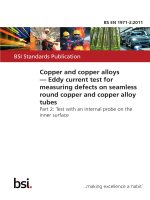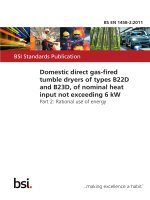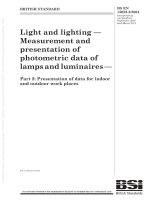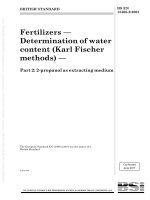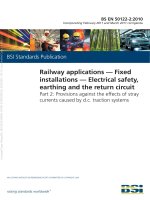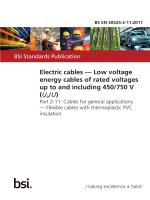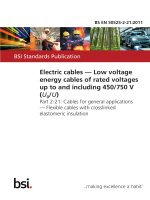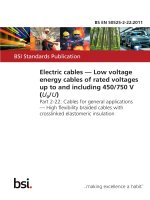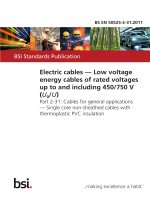Bsi bs en 61558 2 12 2011
Bạn đang xem bản rút gọn của tài liệu. Xem và tải ngay bản đầy đủ của tài liệu tại đây (1.16 MB, 24 trang )
BS EN 61558-2-12:2011
BSI Standards Publication
Safety of transformers,
reactors, power supply units
and combinations thereof
Part 2-12: Particular requirements and tests for
constant voltage transformers and power supply
units for constant voltage
BRITISH STANDARD
BS EN 61558-2-12:2011
National foreword
This British Standard is the UK implementation of EN 61558-2-12:2011. It is
identical to IEC 61558-2-12:2011. It supersedes BS EN 61558-2-12:2001,
which will be withdrawn on 3 March 2014.
The UK participation in its preparation was entrusted to Technical Committee
PEL/96, Small transformers.
A list of organizations represented on this committee can be obtained on
request to its secretary.
This publication does not purport to include all the necessary provisions of a
contract. Users are responsible for its correct application.
© BSI 2011
ISBN 978 0 580 64546 4
ICS 29.180
Compliance with a British Standard cannot confer immunity from
legal obligations.
This British Standard was published under the authority of the Standards
Policy and Strategy Committee on 31 May 2011.
Amendments issued since publication
Amd. No.
Date
Text affected
BS EN 61558-2-12:2011
EUROPEAN STANDARD
EN 61558-2-12
NORME EUROPÉENNE
March 2011
EUROPÄISCHE NORM
ICS 29.180
Supersedes EN 61558-2-12:2001
English version
Safety of transformers, reactors, power supply units
and combinations thereof Part 2-12: Particular requirements and tests for constant voltage
transformers and power supply units for constant voltage
(IEC 61558-2-12:2011)
Sécurité des transformateurs, bobines
d'inductance, blocs d'alimentation et des
combinaisons de ces éléments Partie 2-12: Exigences particulières et
essais pour les transformateurs à tension
constante et les blocs d'alimentation pour
tension constante
(CEI 61558-2-12:2011)
Sicherheit von Transformatoren, Drosseln,
Netzgeräten und entsprechende
Kombinationen Teil 2-12: Besondere Anforderungen und
Prüfungen für magnetische
Spannungskonstanthalter und Netzgeräte,
die Spannungskonstanthalter enthalten
(IEC 61558-2-12:2011)
This European Standard was approved by CENELEC on 2011-03-03. CENELEC members are bound to comply
with the CEN/CENELEC Internal Regulations which stipulate the conditions for giving this European Standard
the status of a national standard without any alteration.
Up-to-date lists and bibliographical references concerning such national standards may be obtained on
application to the Central Secretariat or to any CENELEC member.
This European Standard exists in three official versions (English, French, German). A version in any other
language made by translation under the responsibility of a CENELEC member into its own language and notified
to the Central Secretariat has the same status as the official versions.
CENELEC members are the national electrotechnical committees of Austria, Belgium, Bulgaria, Croatia, Cyprus,
the Czech Republic, Denmark, Estonia, Finland, France, Germany, Greece, Hungary, Iceland, Ireland, Italy,
Latvia, Lithuania, Luxembourg, Malta, the Netherlands, Norway, Poland, Portugal, Romania, Slovakia, Slovenia,
Spain, Sweden, Switzerland and the United Kingdom.
CENELEC
European Committee for Electrotechnical Standardization
Comité Européen de Normalisation Electrotechnique
Europäisches Komitee für Elektrotechnische Normung
Management Centre: Avenue Marnix 17, B - 1000 Brussels
© 2011 CENELEC - All rights of exploitation in any form and by any means reserved worldwide for CENELEC members.
Ref. No. EN 61558-2-12:2011 E
BS EN 61558-2-12:2011
EN 61558-2-12:2011
Foreword
The text of document 96/370/FDIS, future edition 2 of IEC 61558-2-12, prepared by IEC TC 96,
Transformers, reactors, power supply units and similar products for low voltage up to 1 100 V, was
submitted to the IEC-CENELEC parallel vote and was approved by CENELEC as EN 61558-2-12 on
2011-03-03.
This European Standard supersedes EN 61558-2-12:2001.
The main changes consist of updating EN 61558-2-12:2011 in accordance with EN 61558-1:2005 +
A1:2009.
This standard is to be used in conjunction with EN 61558-1:2005 + A1:2009
This part supplements or modifies the corresponding clauses in EN 61558-1, so as to convert that
publication into the European Standard: Particular requirements and tests for constant voltage
transformers and power supply units for constant voltage.
Where a particular subclause of Part 1 is not mentioned in this part, that subclause applies as far as is
reasonable. Where this part states "addition", "modification" or "replacement", the relevant text of Part 1
has to be adopted accordingly.
In this part, the following print types are used:
− requirements proper: in roman type;
− test specifications: in italic type;
− explanatory matter: in smaller roman type.
In the text of this part the words in bold are defined in Clause 3.
Subclauses, notes, figures and tables are additional to those in Part 1 are numbered starting from 101;
supplementary annexes are entitled AA, BB, etc.
Attention is drawn to the possibility that some of the elements of this document may be the subject of
patent rights. CEN and CENELEC shall not be held responsible for identifying any or all such patent
rights.
The following dates were fixed:
– latest date by which the EN has to be implemented
at national level by publication of an identical
national standard or by endorsement
(dop)
2011-12-03
– latest date by which the national standards conflicting
with the EN have to be withdrawn
(dow)
2014-03-03
__________
Endorsement notice
The text of the International Standard IEC 61558-2-12:2011 was approved by CENELEC as a European
Standard without any modification.
In the official version, for Bibliography, the following note has to be added for the standard indicated:
IEC 61558-2-16:2009
NOTE Harmonized as EN 61558-2-16:2009 (not modified).
__________
BS EN 61558-2-12:2011
61558-2-12 IEC:2011
CONTENTS
1
Scope . ............................................................................................................................................. 5
2
Normative references . .................................................................................................................. 7
3
Terms and definitions . .................................................................................................................. 7
4
General requirements . .................................................................................................................. 7
5
General notes on tests . ................................................................................................................ 7
6
Ratings . ........................................................................................................................................... 7
7
Classification . ................................................................................................................................. 8
8
Marking and other information ..................................................................................................... 8
9
Protection against electric shock . ............................................................................................... 9
10 Change of input voltage setting . ................................................................................................. 9
11 Output voltage and output current under load ........................................................................... 9
12 No-load output voltage ............................................................................................................... 10
13 Short-circuit voltage . .................................................................................................................. 11
14 Heating ......................................................................................................................................... 11
15 Short-circuit and overload protection . ...................................................................................... 11
16 Mechanical strength . .................................................................................................................. 12
17 Protection against harmful ingress of dust, solid objects and moisture ............................... 12
18 Insulation resistance, dielectric strength and leakage current . ............................................ 12
19 Construction ................................................................................................................................. 13
20 Components ................................................................................................................................. 17
21 Internal wiring . ............................................................................................................................. 17
22 Supply connection and other external flexible cables or cords . ........................................... 17
23 Terminals for external conductors ............................................................................................. 17
24 Provision for protective earthing . .............................................................................................. 17
25 Screws and connections ............................................................................................................. 17
26 Creepage distances, clearances and distances through insulation . .................................... 17
27 Resistance to heat, fire and tracking . ....................................................................................... 18
28 Resistance to rusting . ................................................................................................................. 18
Annexes . ............................................................................................................................................. 19
Annex C (normative) . ......................................................................................................................... 19
Annex D (normative) . ......................................................................................................................... 19
Annex L (normative) . ......................................................................................................................... 19
Annex R (normative) . ......................................................................................................................... 19
Bibliography ......................................................................................................................................... 20
BS EN 61558-2-12:2011
61558-2-12 IEC:2011
–5–
SAFETY OF TRANSFORMERS, REACTORS,
POWER SUPPLY UNITS AND COMBINATION THEREOF –
Part 2-12: Particular requirements and tests
for constant voltage transformers
and power supply units for constant voltage
1
Scope
Replacement:
This part of IEC 61558 deals with the safety of constant voltage transformers for general
applications and power supply units for constant voltage for general applications.
Constant voltage transformers incorporating electronic circuits are also covered by this
standard.
NOTE 1
Safety includes electrical, thermal and mechanical aspects.
Unless otherwise specified, from here onward, the term transformer covers constant
voltage transformers for general applications and power supply units for constant voltage
for general applications.
This part is applicable to stationary or portable, single-phase or polyphase, air-cooled
(natural or forced), independent or associated dry-type:
–
constant voltage auto-transformers;
–
constant voltage separating transformers;
–
constant voltage isolating transformers;
–
constant voltage safety isolating transformers.
The windings may be encapsulated or non-encapsulated.
This standard is applicable to transformers and power supply (linear) with internal operating
frequencies not exceeding 500 Hz.
This standard used in combination with Part 2-16 for switch mode power supply (SMPS)
units is also applicable to power supplies with internal operating frequencies higher than
500 Hz. Where the two requirements are in conflict, the most severe take precedence.
The rated supply voltage does not exceed 1 000 V a.c., the rated supply frequency does
not exceed 500 Hz, the internal operating resonant frequency does not exceed 30 kHz and
the internal operating frequency does not exceed 100 MHz.
The rated output does not exceed:
–
40 kVA for single-phase constant voltage auto-transformers;
–
200 kVA for poly-phase constant voltage auto-transformers;
–
25 kVA for single-phase constant voltage separating transformers and constant
voltage isolating transformers;
–
40 kVA for poly-phase constant voltage separating transformers and constant
voltage isolating transformers;
–
10 kVA for single-phase constant voltage safety isolating transformers;
BS EN 61558-2-12:2011
–6–
–
61558-2-12 IEC:2011
16 kVA for poly-phase constant voltage safety isolating transformers.
This part is applicable to transformers without limitation of the rated output subject to an
agreement between the purchaser and the manufacturer.
NOTE 2
Transformers intended to supply distribution networks are not included in the scope.
Where applicable to constant voltage auto-transformers
–
the no-load output voltage or the rated output voltage does not exceed 1 000 V a.c. or
1 415 V ripple-free d.c., and for independent constant voltage auto-transformers, the
no-load output voltage and the rated output voltage exceed 50 V a.c. or 120 V ripplefree d.c.;
–
constant voltage auto-transformers covered by this part are used only in applications
where no insulation between circuits is required by the installation rules or by the end
product standard.
Where applicable to constant voltage separating transformers
–
the no-load output voltage or the rated output voltage does not exceed 1 000 V a.c. or
1 415 V ripple-free d.c., and for independent constant voltage separating
transformers, the no-load output voltage and the rated output voltage exceed 50 V
a.c. or 120 V ripple-free d.c.;
–
constant voltage separating transformers covered by this part are used only in
applications where double or reinforced insulation between circuits is not required by
the installation rules or by the end product standard.
Where applicable to constant voltage isolating transformers
–
the no-load output voltage or the rated output voltage does exceed 50 V a.c. or 120 V
ripple-free d.c. and where applicable, does not exceed 500 V a.c. or 708 V ripple-free d.c.
The no-load output voltage and the rated output voltage may be up to 1 000 V a.c. or
1 415 V ripple-free d.c. for special applications;
–
constant voltage isolating transformers covered by this part are used only in
applications where double or reinforced insulation between circuits is required by the
installation rules or by the end product standard.
Where applicable to constant voltage safety isolating transformers
–
the no-load output voltage or the rated output voltage does not exceed 50 V a.c. or
120 V ripple-free d.c.;
–
constant voltage safety isolating transformers covered by this part are used only in
applications where double or reinforced insulation between circuits is required by the
installation rules or by the end product standard.
This part is not applicable to external circuits and their components intended to be connected
to the input terminals and output terminals of the transformers.
NOTE 3
Attention is drawn to the following:
–
for transformers intended to be used in vehicles, on board ships, and aircraft, additional requirements (from
other applicable standards, national rules, etc.) may be necessary;
–
measures to protect the enclosure and the components inside the enclosure against external influences such
as fungus, vermin, termites, solar-radiation, and icing should also be considered;
–
the different conditions for transportation, storage, and operation of the transformers should also be
considered;
–
additional requirements in accordance with other appropriate standards and national rules may be applicable
to transformers intended for use in special environments.
NOTE 4 Future technological development of transformers may necessitate a need to increase the upper limit
of the frequencies, until then this part may be used as a guidance document.
BS EN 61558-2-12:2011
61558-2-12 IEC:2011
2
–7–
Normative references
This clause of Part 1 is applicable.
3
Terms and definitions
This clause of Part 1 is applicable except as follows:
Addition:
3.101
constant voltage transformer
transformer intended to limit the influence of the input voltage variations
NOTE
This type of transformer may also limit the influence of transients.
3.102
regulation tolerance
deviation in per cent of the rated output voltage when the constant voltage transformer is
supplied within the rated supply voltage variation
3.103
internal operating resonant frequency
frequency produced within a constant voltage transformer
4
General requirements
This clause of Part 1 is applicable.
5
General notes on tests
This clause of Part 1 is applicable.
6
Ratings
This clause of Part 1 is applicable except as follows:
Addition:
6.101
The rated output voltage shall not exceed:
–
1 000 V a.c. or 1 415 V ripple-free d.c. for constant voltage auto-transformers and
constant voltage separating transformers;
–
250 V a.c. for single-phase portable constant voltage isolating transformers;
–
400 V a.c. for polyphase portable constant voltage isolating transformers, and
–
500 V a.c. or 708 V ripple-free d.c. for constant voltage isolating transformers. For
constant voltage isolating transformers, the rated output voltage may be up to 1 000
V a.c. or 1 415 V ripple-free d.c. to be in accordance with the national wiring rules or for a
special purpose;
–
50 V a.c. or 120 V ripple-free d.c. for constant voltage safety isolating transformers.
BS EN 61558-2-12:2011
–8–
61558-2-12 IEC:2011
The rated output voltage shall exceed:
–
50 V a.c. or 120 V ripple-free d.c. for independent constant voltage auto-transformers,
constant voltage separating transformers and constant voltage isolating
transformers.
6.102
The rated output shall not exceed:
–
40 kVA for single-phase constant voltage auto-transformers,
–
200 kVA for polyphase constant voltage auto-transformers,
–
25 kVA for single-phase constant voltage separating and isolating transformers,
–
40 kVA for polyphase constant voltage separating and isolating transformers,
–
10 kVA for single-phase constant voltage safety isolating transformers,
–
16 kVA for polyphase constant voltage safety isolating transformers,
except for constant voltage transformers subject to an agreement between the purchaser
and the manufacturer.
6.103
The rated supply frequency shall not exceed 500 Hz.
6.104 The rated value of the output regulation tolerance shall be given at the rated supply
voltage range, the rated output, and the power factor = 1.
6.105 For constant voltage independent transformers, the input voltage variation shall
not be less than 10 %.
6.106
The internal operating resonant frequency shall not exceed 30 kHz.
6.107
The internal operating frequency shall not exceed 100 MHz.
Compliance with 6.101 to 6.107 is checked by inspection of the marking.
7
Classification
This clause of Part 1 is applicable.
8
Marking and other information
This clause of Part 1 is applicable except as follows:
8.1
a)
Replacement of the first sentence by the following:
rated supply voltage(s) and the input voltage variation in %;
8.1
b)
Replacement of the first sentence by the following:
Replace the first sentence by the following:
rated output voltage(s) and the regulation tolerance of this voltage(s) in %;
8.1
h)
Replacement of the first sentence by the following:
relevant graphical symbols shown in 8.11 indicating the kind of transformer;
BS EN 61558-2-12:2011
61558-2-12 IEC:2011
8.11
–9–
Addition:
Symbol or graphical symbol
9
Explanation or title
Fail-safe constant voltage separating transformer
IEC 60417-6011
Non-short-circuit-proof constant voltage
separating transformer
IEC 60417-6011
Short-circuit-proof constant voltage separating
transformer
IEC 60417-6011
Fail-safe constant voltage isolating transformer
IEC 60417-6012
Non-short-circuit-proof constant voltage isolating
transformer
IEC 60417-6012
Short-circuit-proof constant voltage isolating
transformer
IEC 60417-6012
Fail-safe constant voltage safety isolating
transformer
IEC 60417-6013
Non-short-circuit-proof constant voltage safety
isolating transformer
IEC 60417-6013
Short-circuit-proof constant voltage safety
isolating transformer
IEC 60417-6013
Fail-safe constant voltage auto-transformer
IEC 60417-6017
Non-short-circuit-proof constant voltage autotransformer
IEC 60417-6017
Short-circuit-proof constant voltage autotransformer
IEC 60417-6017
Protection against electric shock
This clause of Part 1 is applicable.
10 Change of input voltage setting
This clause of Part 1 is applicable.
11 Output voltage and output current under load
This clause of Part 1 is applicable except as follows:
11.1
Replacement:
Identification
BS EN 61558-2-12:2011
– 10 –
61558-2-12 IEC:2011
11.1 When the transformer is connected to the rated supply voltage plus or minus the
input voltage variation declared by the manufacturer, at the rated supply frequency, and
loaded with an impedance resulting in the rated output at the rated output voltage and, for
a.c., at the rated power factor, the output voltage shall not differ from the rated value by
more than the regulation tolerance.
Compliance is checked by measuring the output voltage when steady-state conditions are
established. During the test, the transformer is connected to the rated supply voltage, plus
or minus the highest input voltage variation, at the rated supply frequency, and loaded with
an impedance resulting in the rated output at the rated output voltage and the rated power
factor.
For transformers incorporating a rectifier, the output voltage shall be measured at the
terminals of the d.c. circuit by means of a voltmeter giving the arithmetical mean value, unless
the effective (r.m.s.) value is specifically stated (see 8.1).
For transformers with more than one rated supply voltage, the requirement is applicable for
each of the rated supply voltages.
For transformers with multiple output windings, the loads are applied to every multiple
section simultaneously, unless otherwise declared.
12 No-load output voltage
This clause of Part 1 is applicable except as follows:
Addition:
The no-load output voltage is measured when the transformer is connected to the rated
supply voltage at the rated supply frequency at ambient temperature.
12.101
The no-load output voltage shall not exceed:
–
1 000 V a.c. or 1 415 V ripple-free d.c. for constant voltage auto-transformers and
constant voltage separating transformers;
–
250 V a.c. for single-phase portable constant voltage isolating transformers;
–
400 V a.c. for polyphase portable constant voltage isolating transformers, and
–
500 V a.c. or 708 V ripple-free d.c. for other constant voltage isolating transformers.
In this case, the no-load output voltage may be up to 1 000 V a.c. or 1 415 V ripple-free
d.c. to be in accordance with the national wiring rules or for special purpose;
–
50 V a.c. or 120 V ripple-free d.c. for constant voltage safety isolating transformers.
The no-load output voltage shall exceed:
–
50 V a.c. or 120 V ripple-free d.c. for constant voltage independent auto-, separating and
isolating transformers.
For independent transformers, this output voltage limitation applies even when output
windings, not intended for interconnection, are connected in series.
12.102 The difference between the no-load output voltage and the output voltage under
load shall not be excessive.
BS EN 61558-2-12:2011
61558-2-12 IEC:2011
– 11 –
The difference between the no-load output voltage measured in this clause and the output
voltage under load measured during the test of Clause 11, expressed as a percentage of the
latter voltage, shall not exceed 10 %.
NOTE
The ratio is defined as follows:
Uno -load − Uload
× 100 %
Uload
where U no-load is the no-load output voltage and U load is the output voltage under load.
Compliance with the requirements of 12.101 and 12.102 shall be checked by measuring the
no-load output voltage at ambient temperature, when the transformer is connected to the
rated supply voltage plus the highest input voltage variation at the rated supply frequency.
13 Short-circuit voltage
This clause of Part 1 is applicable.
14 Heating
This clause of Part 1 is applicable, except as follows:
14.1 Replacement of the 10th paragraph starting with "Transformers are supplied..." by the
following:
The constant voltage transformers are connected to the rated supply voltage and loaded
with an impedance resulting in the rated output, at the rated output voltage and, for a.c., at
the rated power factor. The supply voltage is then increased to the value of the highest input
voltage variation declared by the manufacturer. After this voltage increase, no change or
adjustment is made in the circuit. The test is repeated under no-load condition with the
highest or the lowest input voltage variation if this is a more unfavorable condition.
15 Short-circuit and overload protection
This clause of Part 1 is applicable, except as follows:
15.1 Replacement of the 2nd paragraph starting with " Compliance is checked..." by the
following:
Compliance is checked by inspection and by the following tests, which are carried out
immediately after the test according to 14.1, at the same ambient temperature, and without
changing the position of the constant voltage transformer at the maximum value of the
rated supply voltage designed for the constant voltage transformer.
15.2
Replacement:
Inherently short-circuit-proof constant voltage transformers shall be tested as follows:
Before starting the test, it is necessary to determine the highest output current of the
constant voltage transformer at the maximum value of the supply voltage designed for the
constant voltage transformer. The constant voltage transformer is then loaded with the
maximum output current or the output winding(s) short-circuited, whichever results in
the maximum temperature.
BS EN 61558-2-12:2011
– 12 –
61558-2-12 IEC:2011
15.3 Non-inherently short-circuit-proof constant voltage transformers are tested as
follows:
15.3.1
Replacement:
The output windings are short-circuited or overloaded as stated in 15.2. The incorporated
overload protection device shall operate before the temperature exceeds the values shown in
Table 3 for any value of the supply voltage between the marked values of rated supply
voltage.
15.5
15.5.1
Fail-safe transformers
Replacement:
Three additional specimens are required, only for the following test. Constant voltage
transformers used in other tests are not subjected to this test.
Each of the three specimens is mounted as for normal use on a 20 mm thick dull black
painted plywood surface. Each constant voltage transformer is operated at rated supply
voltage plus or minus the input voltage variation declared by the manufacturer, the output
winding which produced the highest temperature during the test of 14.1 being initially loaded
with 1,5 times the rated output current (or, if this is not possible, the maximum value of the
output current obtainable) until steady-state conditions are reached or the constant voltage
transformer fails (whichever occurs first).
If the constant voltage transformer fails, it shall comply, during and after the tests, with the
criteria given in 15.5.2.
If the constant voltage transformer does not fail, the time to reach steady-state conditions is
noted and the chosen output winding is then short-circuited. The test is continued until the
constant voltage transformer fails. Each specimen shall do so within a duration, for this part
of the test, which is no longer than that necessary to attain steady-state conditions, but in any
case it shall not exceed 5 h.
The constant voltage transformer shall fail safely. It shall comply, during and after the test,
with the criteria given in 15.5.2.
16 Mechanical strength
This clause of Part 1 is applicable.
17 Protection against harmful ingress of dust, solid objects and moisture
This clause of Part 1 is applicable.
18 Insulation resistance, dielectric strength and leakage current
This clause of Part 1 is applicable except as follows:
Modification for constant voltage auto-transformers:
18.2
Insulation resistance
Table 7: values between each input circuit and all other input circuits, between each
output circuits and all other output circuits are not applicable.
BS EN 61558-2-12:2011
61558-2-12 IEC:2011
18.3
– 13 –
Dielectric strength test
This subclause is applicable except as follows:
Modification for constant voltage auto-transformers:
Table 8a: lines 1) and 2) are not applicable.
18.4
Insulation between and within windings
This subclause is applicable except as follows:
Addition:
18.101
Table 101 – Dielectric strength test voltages for constant voltage auto-transformers
Application of dielectrical strength test voltage
Working voltage
V
>50
Over functional insulation for windings intended to be connected
in series or parallel
150
300
Working voltage + 500 V
19 Construction
Replacement of this clause:
NOTE
This clause reads slightly differently for each type of constant voltage transformer:
–
constant voltage auto-transformers (see 19.1);
–
constant voltage separating transformers (see 19.2);
–
constant voltage isolating and safety isolating transformers (see 19.3).
19.1
Constant voltage auto-transformers
19.1.1 Plug-connected constant voltage auto-transformers, where the rated input
voltage is higher than the rated output voltage, shall not have any potential to earth at the
output socket higher than the rated output voltage.
This requirement shall be fulfilled by using one of the following methods:
a) Polarized input and output plug and socket-outlet system
In this case, an instruction shall be given for not using such a transformer with a nonpolarized plug and socket-outlet system.
b) Polarity detecting device (for non polarised input and output plug and socket-outlet
system)
A polarity detecting device shall only energise the output circuit when the potential to earth at
the poles of the output socket does not exceed the rated output voltage. The contact
separation of the breaking device shall be at least of 3 mm in each pole.
NOTE
A magnetic relay is an example of polarity detecting device.
BS EN 61558-2-12:2011
– 14 –
61558-2-12 IEC:2011
Compliance is checked by the following test:
The auto-transformer is connected to the mains at 1,06 times the rated input voltage under
the most unfavourable condition of load and output voltage. The test is repeated with the
polarity of the input reversed. During the test, the measured potential to earth of each pole
shall not exceed the maximum output voltage under load (1,06 times the rated output
voltage taking into account the permissible deviations of Clause 11).
The contact separation of the device shall be 3 mm minimum in each pole.
Compliance is checked by measurement.
If the polarity detecting device uses a current flowing to the earth for the detection, this
current shall not exceed 0,75 mA and shall only be flowing for the period of measurement until
the polarity is reversed.
Compliance is checked by measurement.
All the tests are repeated under the fault conditions of H.2.3 of Part 1. In this case, the
potential to earth of each pole shall not exceed 1,1 times the maximum output voltage under
load for more than 5 s.
Compliance is checked by measurement.
19.1.2 Protection against direct contact with electrical and moving mechanical parts (contact
path and drive) shall be ensured.
Compliance is checked by inspection.
19.2
Constant voltage separating transformers
19.2.1 The input and output circuits shall be electrically separated from each other, and
the construction shall be such that there is no possibility of any connection between these
circuits, either directly or indirectly, via other conductive parts, except by deliberate action.
Compliance is checked by inspection and measurements, taking Clauses 18 and 26 of Part 1
into consideration.
19.2.2 The insulation between the input and output winding(s) shall consist of at least
basic insulation (rated for the working voltage).
In addition, the following applies:
–
for class I transformers, the insulation between the input windings and the body, and
between the output windings and the body, shall consist of at least basic insulation
(both basic insulations rated for the working voltage);
–
for class II transformers, the insulation between the input windings and the body, and
between the output windings and the body, shall consist of double or reinforced
insulation (both double or reinforced insulations rated for the working voltage).
19.2.3 For constant voltage transformers with intermediate conductive part (e.g. the iron
core) or a resonant circuit not connected to the body and located between the input and
output windings, the insulation between the intermediate conductive part (or a resonant
circuit) and the input windings and between the intermediate conductive part (or a resonant
circuit) and the output windings shall consist of at least basic insulation (rated for the
working voltage).
BS EN 61558-2-12:2011
61558-2-12 IEC:2011
– 15 –
NOTE An intermediate conductive part (or a resonant circuit) not separated from the input or output windings
or the body by at least basic insulation is considered to be connected to the relevant part(s).
In addition, the following applies:
–
for class I transformers, the insulation between the input and output windings via the
intermediate conductive parts shall consist of at least basic insulation (rated for the
working voltage);
–
for class II transformers, the insulation between the input windings and the body, and
between the output windings and the body via the intermediate conductive parts shall
consist of double or reinforced insulation (rated for the input and output voltage).
19.2.4
Parts of output circuits may be connected to protective earth.
19.2.5 There shall be no connections between the output circuit and the body, unless - for
associated transformers - allowed by the relevant equipment standard.
Compliance is checked by inspection.
19.3
Constant voltage isolating and safety isolating transformers
19.3.1 The input and output circuits shall be electrically separated from each other, and
the construction shall be such that there is no possibility of any connection between these
circuits, either directly or indirectly, via other conductive parts, except by deliberate action.
Compliance is checked by inspection and measurements, taking Clauses 18 and 26 of Part 1
into consideration.
19.3.1.1 The insulation between the input and output winding(s) shall consist of double or
reinforced insulation (rated for the working voltage) unless the requirements of 19.3.1.3
are complied with.
In addition, the following applies:
–
for class I transformers not intended for connection to the mains supply by means of
a plug, the insulation between the input windings and the body connected to earth
shall consist of at least basic insulation rated for the input voltage. The insulation
between the output windings and the body connected to earth, shall consist of at
least basic insulation (rated for the output voltage);
–
for class I transformers intended for connection to the mains supply by means of a
plug, the insulation between the input windings and the body shall consist of at least
basic insulation, and the insulation between the output windings and the body shall
consist of at least supplementary insulation (both basic and supplementary
insulations rated for the working voltage);
–
for class II transformers, the insulation between the input windings and the body
shall consist of double or reinforced insulation (rated for the input voltage). The
insulation between the output windings and the body, shall consist of double or
reinforced insulation (rated for the output voltage).
19.3.1.2 For constant voltage transformers with intermediate conductive parts (e.g. the
iron core) or a resonant circuit not connected to the body and located between the input and
output windings, the following requirements are applicable:
a)
for class I and class II transformers, the insulation between the input and output
windings via the intermediate conductive parts shall consist of double or
reinforced insulation (rated for the working voltage);
BS EN 61558-2-12:2011
– 16 –
61558-2-12 IEC:2011
–
for class II transformers, the insulation between the input windings and the
body, and between the output windings and the body via the intermediate
conductive parts shall consist of double or reinforced insulation (rated for
the input and output voltage), for SELV circuits basic insulation only is
required.
–
for transformer different from independent (IP00), the insulation between the
input and output windings via the intermediate conductive parts shall
consist of double or reinforced insulation (rated for the working voltage).
b)
as alternative to a) for class I transformer not intended to be connected by means
of a plug and for transformer different from independent (IP00), if the construction
assure that all laminated plates of the iron core are connected to earth (e.g. by
soldering / welding) and if in the data sheet or instruction sheet clearly state that
the safety of the transformer depends on the earth connection and that is not
possible to use in class II equipment, than the following apply: the insulation
between the input windings and the intermediate conductive part connected to
earth, and between the output windings and the intermediate conductive part
connected to earth, shall consist of at least basic insulation (rated for the input
and output voltage);
c)
in addition to a) and b) the insulation between the intermediate conductive parts
and the input windings, and between the intermediate conductive parts and the
output windings shall consist of at least basic insulation (rated for the input and
output voltage). An intermediate conductive part not separated from the input or
output windings or the body by at least basic insulation is considered to be
connected to the relevant part(s).
19.3.1.3 For class I constant voltage transformers not intended for connection to the
mains supply by means of a plug, the insulation between the input and output windings may
consist of basic insulation plus protective screening instead of double or reinforced
insulation, provided the following conditions are complied with:
–
the insulation between the input winding and the protective screen shall comply with the
requirements for basic insulation (rated for the input voltage);
–
the insulation between the output winding and the protective screen shall comply with the
requirements for basic insulation (rated for the output voltage);
–
the protective screen shall, unless otherwise specified, consist of a metal foil or of a wire
wound screen extending at least the full width of the input winding and shall have no
gaps or holes;
–
where the protective screen does not cover the entire width of the input winding,
additional adhesive tapes or equivalent insulation shall be used to ensure double
insulation in that area;
–
if the protective screen is made of a foil, the turns shall be insulated from each other. In
case of only one turn, it shall have an isolated overlap of at least 3 mm;
–
the wire of a wire wound screen and the lead out wire of the protective screen shall have a
cross-sectional area at least corresponding to the rated current of the overload device to
ensure that if a breakdown of insulation should occur, the overload protective device will
open the circuit before the lead-out wire is destroyed;
–
the lead-out wire shall be soldered to the protective screen or secured in an equally
reliable manner.
NOTE For the purpose of this subclause, the term "windings" does not include internal circuits such as the
resonant circuit.
Examples of the construction of windings are given in Annex M of Part 1.
19.3.1.4 Transformers shall not be provided with capacitors which electrically connect
input and output circuits.
BS EN 61558-2-12:2011
61558-2-12 IEC:2011
– 17 –
19.3.2 There shall be no connection between the output circuits and the protective earth,
unless this is allowed for associated transformers by the relevant equipment standard.
19.3.3 There shall be no connection between the output circuit and the body, unless this is
allowed for associated transformers by the relevant equipment standard.
Compliance is checked by inspection.
19.3.4 The input and output terminals for the connection of external wiring shall be so
located that the distance measured between the points of introduction of the conductors into
these terminals is not less than 25 mm. If a barrier is used to obtain this distance, the
measurement shall be made over and around the barrier which shall be of insulating material
and be permanently fixed to the transformer.
Compliance is checked by inspection and by measurement disregarding intermediate
conductive parts.
19.3.5 Portable transformers having a rated output not exceeding 630 VA shall be
class II.
19.3.6 For transformers for connection to the mains by the means of a plug of many type
(incorporating or not), the alternative with basic insulation plus protective screening is not
allowed.
20 Components
This clause of Part 1 is applicable.
21 Internal wiring
This clause of Part 1 is applicable.
22 Supply connection and other external flexible cables or cords
This clause of Part 1 is applicable.
23 Terminals for external conductors
This clause of Part 1 is applicable.
24 Provision for protective earthing
This clause of Part 1 is applicable.
25 Screws and connections
This clause of Part 1 is applicable.
26 Creepage distances, clearances and distances through insulation
This clause of Part 1 is applicable.
BS EN 61558-2-12:2011
– 18 –
27 Resistance to heat, fire and tracking
This clause of Part 1 is applicable.
28 Resistance to rusting
This clause of Part 1 is applicable.
61558-2-12 IEC:2011
BS EN 61558-2-12:2011
61558-2-12 IEC:2011
– 19 –
Annexes
The annexes of Part 1 are applicable except as follows:
Annex C
(normative)
Creepage distances (cr), clearances (cl) and distances through insulation
(dti) – Material group II (400 ≤CTI <600)
This annex of Part 1 is applicable, except as follows:
Modification for Constant voltage auto-transformers:
Line 3) of Table C.1 is for functional insulation.
Annex D
(normative)
Creepage distances (cr), clearances (cl) and distances through insulation
(dti) – Material group I (CTI ≥600)
This annex of Part 1 is applicable, except as follows:
Modification for constant voltage auto-transformers:
Line 3) of Table D.1 is for functional insulation.
Annex L
(normative)
Routine tests (production tests)
This annex of Part 1 is applicable except as follows:
Addition:
L.101 The output voltage regulation tolerance shall be within the limit declared by the
manufacturer.
Compliance is checked by measurement of the output voltage regulation tolerance at rated
output according to 11.1 but at room temperature 25 °C ± 10 °C with the transformer in cold
condition.
Annex R
(normative)
Explanations of the application of 4.1.1.2.1 of IEC 60664-1 (see 26.2)
This annex of Part 1 is applicable.
BS EN 61558-2-12:2011
– 20 –
61558-2-12 IEC:2011
Bibliography
The Bibliography of Part 1 is applicable except as follows:
Addition:
IEC 61558-2-16:2009, Safety of transformers, reactors, power supply units and similar
products for supply voltages up to 1 100 V – Part 2-16: Particular requirements and tests for
switch mode power supply units and transformers for switch mode power supply units
___________
This page deliberately left blank
This page deliberately left blank
NO COPYING WITHOUT BSI PERMISSION EXCEPT AS PERMITTED BY COPYRIGHT LAW
British Standards Institution (BSI)
BSI is the national body responsible for preparing British Standards and other
standards-related publications, information and services.
BSI is incorporated by Royal Charter. British Standards and other standardization
products are published by BSI Standards Limited.
About us
Revisions
We bring together business, industry, government, consumers, innovators
and others to shape their combined experience and expertise into standards
-based solutions.
Our British Standards and other publications are updated by amendment or revision.
The knowledge embodied in our standards has been carefully assembled in
a dependable format and refined through our open consultation process.
Organizations of all sizes and across all sectors choose standards to help
them achieve their goals.
Information on standards
We can provide you with the knowledge that your organization needs
to succeed. Find out more about British Standards by visiting our website at
bsigroup.com/standards or contacting our Customer Services team or
Knowledge Centre.
Buying standards
You can buy and download PDF versions of BSI publications, including British
and adopted European and international standards, through our website at
bsigroup.com/shop, where hard copies can also be purchased.
If you need international and foreign standards from other Standards Development
Organizations, hard copies can be ordered from our Customer Services team.
Subscriptions
Our range of subscription services are designed to make using standards
easier for you. For further information on our subscription products go to
bsigroup.com/subscriptions.
With British Standards Online (BSOL) you’ll have instant access to over 55,000
British and adopted European and international standards from your desktop.
It’s available 24/7 and is refreshed daily so you’ll always be up to date.
You can keep in touch with standards developments and receive substantial
discounts on the purchase price of standards, both in single copy and subscription
format, by becoming a BSI Subscribing Member.
PLUS is an updating service exclusive to BSI Subscribing Members. You will
automatically receive the latest hard copy of your standards when they’re
revised or replaced.
To find out more about becoming a BSI Subscribing Member and the benefits
of membership, please visit bsigroup.com/shop.
With a Multi-User Network Licence (MUNL) you are able to host standards
publications on your intranet. Licences can cover as few or as many users as you
wish. With updates supplied as soon as they’re available, you can be sure your
documentation is current. For further information, email
BSI Group Headquarters
389 Chiswick High Road London W4 4AL UK
We continually improve the quality of our products and services to benefit your
business. If you find an inaccuracy or ambiguity within a British Standard or other
BSI publication please inform the Knowledge Centre.
Copyright
All the data, software and documentation set out in all British Standards and
other BSI publications are the property of and copyrighted by BSI, or some person
or entity that owns copyright in the information used (such as the international
standardization bodies) and has formally licensed such information to BSI for
commercial publication and use. Except as permitted under the Copyright, Designs
and Patents Act 1988 no extract may be reproduced, stored in a retrieval system
or transmitted in any form or by any means – electronic, photocopying, recording
or otherwise – without prior written permission from BSI. Details and advice can
be obtained from the Copyright & Licensing Department.
Useful Contacts:
Customer Services
Tel: +44 845 086 9001
Email (orders):
Email (enquiries):
Subscriptions
Tel: +44 845 086 9001
Email:
Knowledge Centre
Tel: +44 20 8996 7004
Email:
Copyright & Licensing
Tel: +44 20 8996 7070
Email:
